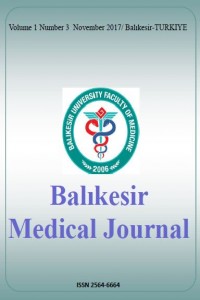Öz
Giriş: Onikomikoz
el ve ayak tırnaklarının mantar enfeksiyonudur. Ayak tırnaklarında el
tırnaklarından daha fazla görülen, sarı, beyaz ve kahverengi renk değişikliği
oluşan onikoliz ve subungal hiperkeratoz gibi klinik görünümlere sahiptir. Bu
olguda palyatif bakım ünitesinde yatmakta olan hastada gelişen onikomikoz ve
buna bağlı oluşan subungal hiperkeratoz tablosunu ilginç görünümü nedeniyle
sunmayı amaçladık.
Olgu: Kalp
yetmezliği, Alzheimer tanılarına sahip, yatağa bağımlı olan 89 yaşında erkek
hasta beslenme bozukluğu ve dekübit ülserleri nedeniyle palyatif bakım
ünitesine yatırıldı. Genel durumu orta, bilinci açık olan hastanın oral alımı
yoktu. Hastanın her iki ayak başparmak tırnakları 5 cm uzunluğunda 3 cm
genişliğinde sarı beyaz renkte ve pürüzlü görünümde idi. Boynuz şeklinde ayak
sırtına doğru uzama gösteriyordu. Diğer tırnakları da sarı kahverengi renkte,
sert ve kalın görünümde idi (Şekil 1). Hematoksilen-eozin boyama ile patoloji
görüntüsünde keratinöz materyal içerisinde mantar sporları izlendi (Şekil 2).
Tartışma: Hastayla ilgilenen hekim hastasına bütüncül yaklaşmalı
ve sadece mevcut hastalıkları değil risk oluşturabilecek durumları da
yönetebilmelidir. Özellikle immün sistemi zayıf olan hastalarda önemli bir
morbidite sebebi olan onikomikoz açısından ayakların değerlendirilmesi de bu
tür hastalarda rutin muayenenin bir parçası olmalıdır
Anahtar Kelimeler
Kaynakça
- 1. Gül Ü. Derinin Yüzeysel Dermatofit Enfeksiyonları. Ankara Med J 2014; 14(3): 107-113.
- 2. Köse ÖK, Güleç AT. Onikomikoz Tanı ve Tedavisi. Turkiye Klinikleri Journal of Dermatology Special Topics 2016; 9(3): 13-19.
- 3. Kuyucu N. Non-İnvaziv Mukokutanöz Fungal Enfeksiyonlarda Tedavi. Güncel Pediatri 2006; 4: 147-149.
- 4. Üçkan Ş, Özbilge H. Derinin Yüzeyel Mantar İnfeksiyonları. Erciyes Üniversitesi, Eczacılık Fakültesi, Eczacılık Temel Bilimleri Anabilim Dalı Bitirme Tezi, Kayseri, 2012. (available to: https://pharmacy.erciyes.edu.tr/ckfinder/userfiles/files/bitirmeler/Seyda_%C3%9C%C3%A7kan_Tez.pdf)
- 5. Uludağ MO. Diyabete bağlı ikincil hastalıklar (komplikasyonlar). Diyabet ve Obezite 2010; 23: 39-43.
- 6. Eskiyurt N. Yaşlılarda Ayak Sorunları ve Tedavisi. Turkiye Klinikleri Journal of Physical Medicine Rehabilitation Special Topics 2010; 3(2): 62-68.
- 7. Tüzün Ç, Tıkız C. Yaşlılarda Ayak Sorunları. Turkish Journal of Geriatrics 2003; 6(4): 135-141.
- 8. Yazıcı A. Yaşlanmaya Bağlı Saç ve Tırnak Değişiklikleri. Turkiye Klinikleri Journal of Cosmetic Dermatology Special Topics 2012; 5(2): 57-63.
- 9. Güdücüoğlu H, Akdeniz N, Bozkurt H ve ark. Beden Eğitimi Bölümü Öğrencilerinin Yüzeyel Mantar Hastalıkları Açısından Değerlendirilmesi. Van Tıp Dergisi 2006; 13 (2): 53-55.
- 10. Taşkıran B, Güldiken S, Turgut N ve ark. Diyabetik Ayak Gelişiminde Elektrofizyolojik Risk Faktörü: Posterior Tibiyal Sinir İleti Bozukluğu. Yeni Symposium 2009; 47(2): 76-79.
Öz
Introduction: Onychomicosis
is the fungal infection of the hand and foot nails. It has different clinical
appearances like onycholysis and subungal hyperkeratosis which are seen with
yellow, white and brown color changes and more frequent in foot nails than the
hand nails. In this case we aimed to present the onychomycosis, and the subungal
hyperkeratosis which is developed because of the onychomycosis, in a patient
hospitalized in palliative care unit owing to its interesting feature
appearance.
Case: 89 years old
patient with heart failure and Alzheimer was hospitalized to palliative care unit
for the treatment of nutritional insufficiency and decubitus. The general
status of the patient was moderate, he was conscious, but was not able to feed
orally. Both toes nails of the patient were 5 cm in length and 3 cm in width, white-yellow
colored rugged. They were lying through the feet surface like a horn. All other
feet nails were yellow-brown colored, stiff and thick (Figure 1). In microscopical
examination of the hematoxylin-eosin stained ceratosis material fungal spores
were viewed (Figure 2).
Conclusions: Physician who take care of the patient must
show a holistic approach to manage not only the present diseases but also the
conditions that may generate a risk to the patient. Examination of the feet should
be a part of the routine physical examination especially in the immune
compromised patients in whom onychomycosis is an important cause of morbidity.
Anahtar Kelimeler
Kaynakça
- 1. Gül Ü. Derinin Yüzeysel Dermatofit Enfeksiyonları. Ankara Med J 2014; 14(3): 107-113.
- 2. Köse ÖK, Güleç AT. Onikomikoz Tanı ve Tedavisi. Turkiye Klinikleri Journal of Dermatology Special Topics 2016; 9(3): 13-19.
- 3. Kuyucu N. Non-İnvaziv Mukokutanöz Fungal Enfeksiyonlarda Tedavi. Güncel Pediatri 2006; 4: 147-149.
- 4. Üçkan Ş, Özbilge H. Derinin Yüzeyel Mantar İnfeksiyonları. Erciyes Üniversitesi, Eczacılık Fakültesi, Eczacılık Temel Bilimleri Anabilim Dalı Bitirme Tezi, Kayseri, 2012. (available to: https://pharmacy.erciyes.edu.tr/ckfinder/userfiles/files/bitirmeler/Seyda_%C3%9C%C3%A7kan_Tez.pdf)
- 5. Uludağ MO. Diyabete bağlı ikincil hastalıklar (komplikasyonlar). Diyabet ve Obezite 2010; 23: 39-43.
- 6. Eskiyurt N. Yaşlılarda Ayak Sorunları ve Tedavisi. Turkiye Klinikleri Journal of Physical Medicine Rehabilitation Special Topics 2010; 3(2): 62-68.
- 7. Tüzün Ç, Tıkız C. Yaşlılarda Ayak Sorunları. Turkish Journal of Geriatrics 2003; 6(4): 135-141.
- 8. Yazıcı A. Yaşlanmaya Bağlı Saç ve Tırnak Değişiklikleri. Turkiye Klinikleri Journal of Cosmetic Dermatology Special Topics 2012; 5(2): 57-63.
- 9. Güdücüoğlu H, Akdeniz N, Bozkurt H ve ark. Beden Eğitimi Bölümü Öğrencilerinin Yüzeyel Mantar Hastalıkları Açısından Değerlendirilmesi. Van Tıp Dergisi 2006; 13 (2): 53-55.
- 10. Taşkıran B, Güldiken S, Turgut N ve ark. Diyabetik Ayak Gelişiminde Elektrofizyolojik Risk Faktörü: Posterior Tibiyal Sinir İleti Bozukluğu. Yeni Symposium 2009; 47(2): 76-79.
Ayrıntılar
| Konular | Klinik Tıp Bilimleri |
|---|---|
| Bölüm | OLGU SUNUMU |
| Yazarlar | |
| Yayımlanma Tarihi | 19 Aralık 2017 |
| Yayımlandığı Sayı | Yıl 2017 Cilt: 1 Sayı: 3 |

Bu eser Creative Commons Alıntı-GayriTicari-Türetilemez 4.0 Uluslararası Lisansı ile lisanslanmıştır.


